A cheerful harbinger of autumn, pumpkins are highly versatile fruits with a wide range of uses, from culinary applications to spooking kids at Halloween!
Loaded with valuable nutrients, they’re rich in antioxidants, minerals, and vitamins. The bright orange flesh has a delicious, sweetly nutty flavor when cooked, making it a classic ingredient in sweet dishes like muffins, pancakes, and pies.
They are equally adept in savory recipes as well, served as a scrumptious roasted side dish or a rich and satisfying entree.
Plus, the toasted seeds make a tasty and nutritious snack!
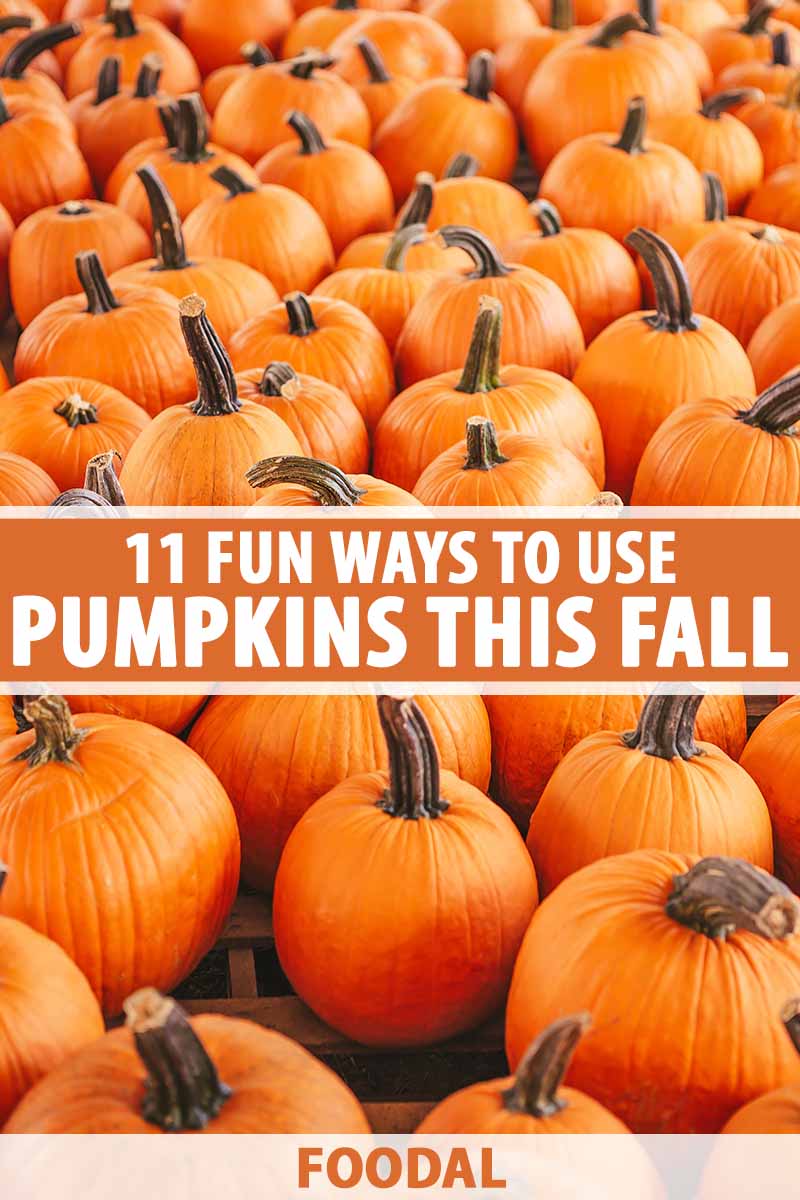
A type of winter squash, the round orange fruits are instantly recognizable, although they also come in different colors, with green, red, white, and yellow varieties.
Among the oldest of domesticated foods, pumpkins – one of the hundreds of species in the Cucurbitaceae family, or cucurbits for short – are easily grown in the home garden, and they’re readily available at grocery stores and markets starting in the late summer.
You can read all about growing and harvesting them in our growing guide on our sister site, Gardeners Path.
Easily carved and hollowed, they are both fun and functional, giving us iconic fall vessels like jack-o’-lanterns, punch bowls, or soup tureens.
And what would the autumn holidays be without a few orange gourds decorating our homes?
Tasty, nutritious, and fun, are you ready for some gourd-y goodness this fall? Then let’s get the scoop on 11 fun ways to use pumpkins!
Here’s what you’ll find ahead:
11 Fun Ways to Use Pumpkins This Fall
The Basics
A type of winter squash that’s also identified as a gourd, the pumpkins we grow or buy at the local market belong to the genus Cucurbita, with the most common varieties from the species C. pepo, C. maxima, and C. moschata.
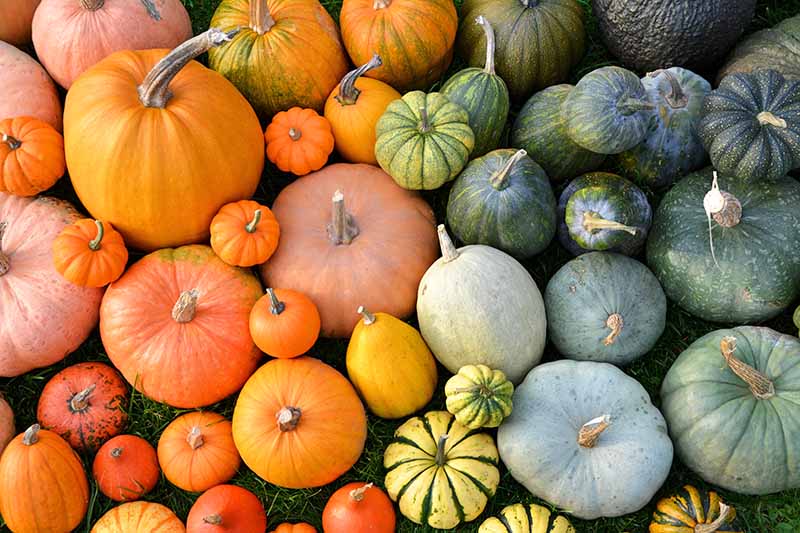
Technically, they’re a fruit – a modified berry known as a pepo, but they’re cultivated and consumed as a vegetable.
And the varieties sold for Halloween jack-o’-lanterns, known as carving types, are different from the pie or baking types.
The carving types are bred for their appealing aesthetics, most notably a smooth, bright orange rind and large, symmetrically round or oblong shapes. These are the ones often sold in big bins at grocery stores and local farms prior to Halloween.
Baking varieties, also called sugar or pie types, are noted for their sweet, thick flesh with less stringy pulp than the carving varieties.
Baking or pie types are usually smaller than carving varieties and not as “pretty,” often with flattened tops or odd shapes – but their dense flesh is richly flavored with a tender, velvety texture when cooked.
Sugar varieties are typically found in the produce section in grocery stores and markets over the fall and winter seasons.
The commercially available canned puree for cooking is processed from popular pie varieties like Cinderella and Dickinson.
These globular gourds have an impressive nutritional profile. They’re a good source of vitamins A and C, as well as the minerals iron, magnesium, and potassium, plus carotenoids like lutein, alpha, and beta carotenes.
An historically important food staple for Native Americans, colonists were cultivating them by the early 1600s. And they’re still a staple in today’s garden.
Standard fare at celebrations like Halloween and Thanksgiving, let’s check out how to select fresh gourds for carving and cooking.
How to Select
Choose selections with healthy, firm skin that’s free of cracks and splits as well as discolored, soft, or sunken spots.
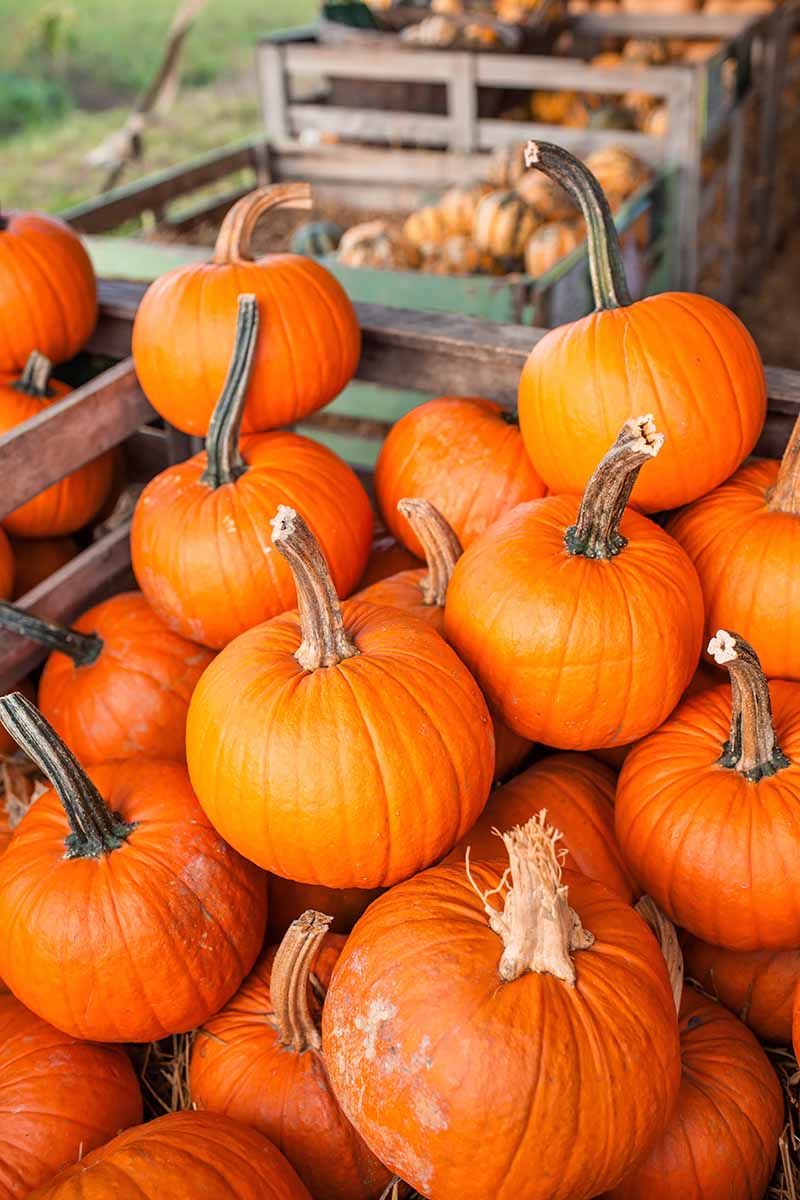
The rind should have a bright color and resist scratching when you lightly press your fingernail into it.
Look for those with a firm, bright green stem, which is a good indication of freshness.
But never carry one by the stem – its connection to the fruit may not be strong enough to support the full weight. And once the stem comes off, decay isn’t far behind.
If you need to store your gourd for a few days, place it in a cool and dry location out of direct sunlight and set it on a piece of cardboard to prevent it absorbing external moisture.
The 11 Ways
When you’re ready to use your gorgeous gourds, check out the following uses to have some fun all fall long!
And be sure to visit this recipe for fresh and flavorful homemade puree, an important base for many classic autumnal goodies.
1. Beverages and Smoothies
Adding a dollop of puree and a dash of pumpkin pie spice – what we like to call PPS – can transform a range of drinks like cocktails and coffee into delightful, seasonal bevvies.
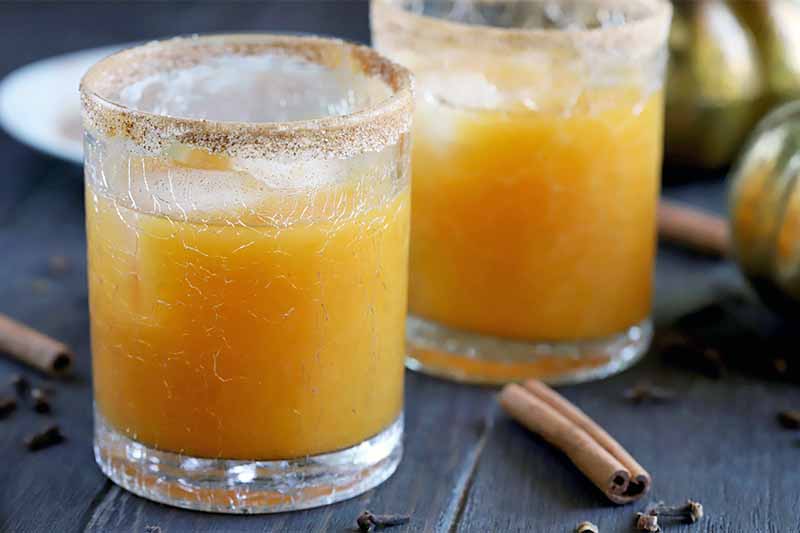
Pumpkin Margarita – Get the Recipe Now
You can start your day by drinking a hot coffee swirled with a sweet and spicy coffee creamer, or sipping on a healthy oatmeal smoothie.
The puree adds a heavenly taste and rich texture to a big mug of hot chocolate. Our recipe for hot white chocolate will be a unique drink base for whisking in a dollop of puree.
Don’t know what to do with leftover pie? Don’t let it go to waste! Add it to a blender with milk and ice cream for a thick and sumptuous milkshake.
And a fall-flavored cocktail is a sure way to liven up the ghouls at any Halloween party!
2. Desserts and Sweets
You know and love all the sweet classics in the realm of pumpkin recipes – let’s celebrate them here!
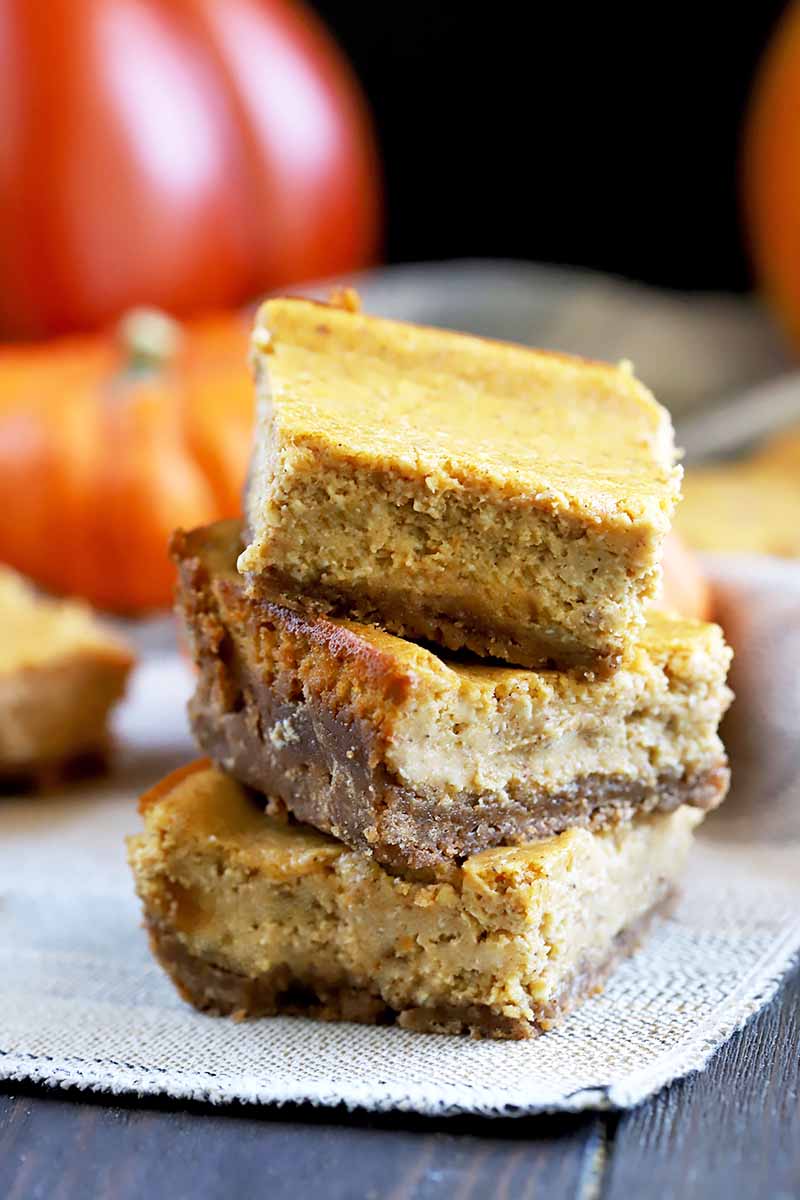
Pumpkin Cheesecake Bars – Get the Recipe Now
The baking, pie, or sweet varieties have a naturally sugary flavor that makes a welcome addition to sweet desserts, snacks, breakfasts, and other foods.
Use the puree in a huge range of sweetly flavored recipes that include blondies, breads, brittle, brownies, cake, cheesecake, churros, cinnamon rolls, cookies, crisp or crumble, cupcakes, doughnuts, fudge, granola bars, ice cream, madeleines, muffins, pancakes, pie, pudding, scones, tiramisu, trifle, truffles, and waffles.
It’s particularly outstanding when combined in a recipe with chocolate – okay, everything is outstanding with chocolate! – like our chocolate swirl pumpkin bread.
3. Dips and Spreads
With its thick and creamy texture, the puree makes a delicious addition to a savory dip or spread for bagels, breads, chips, crackers, muffins, and vegetables.
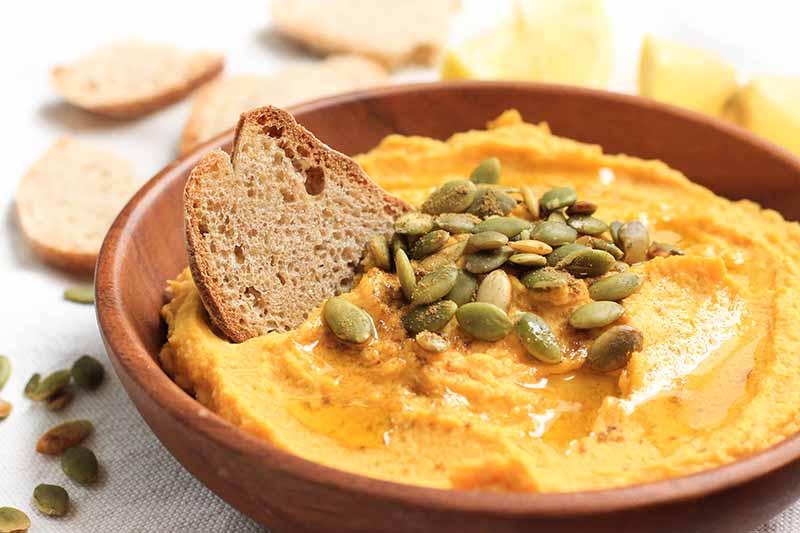
Pumpkin Hummus – Get the Recipe Now
Try mixing it with PPS and cream cheese or Greek yogurt for a tangy bagel spread or chip dip. Or create a mouthwatering hummus that’s perfect for fall-themed charcuterie, cheese and cracker, or veggie trays.
And to warm up those chilly fall mornings, blend some with butter, maple syrup, and PPS for a sweetly spicy spread on toast, pancakes, or waffles – or add a pat to a bowl of piping hot oatmeal or quinoa.
4. Spice Blend
Speaking of the iconic fall spice blend, I’ll let you in on a secret:
You don’t have to buy prepared spice blends like pumpkin pie spice.
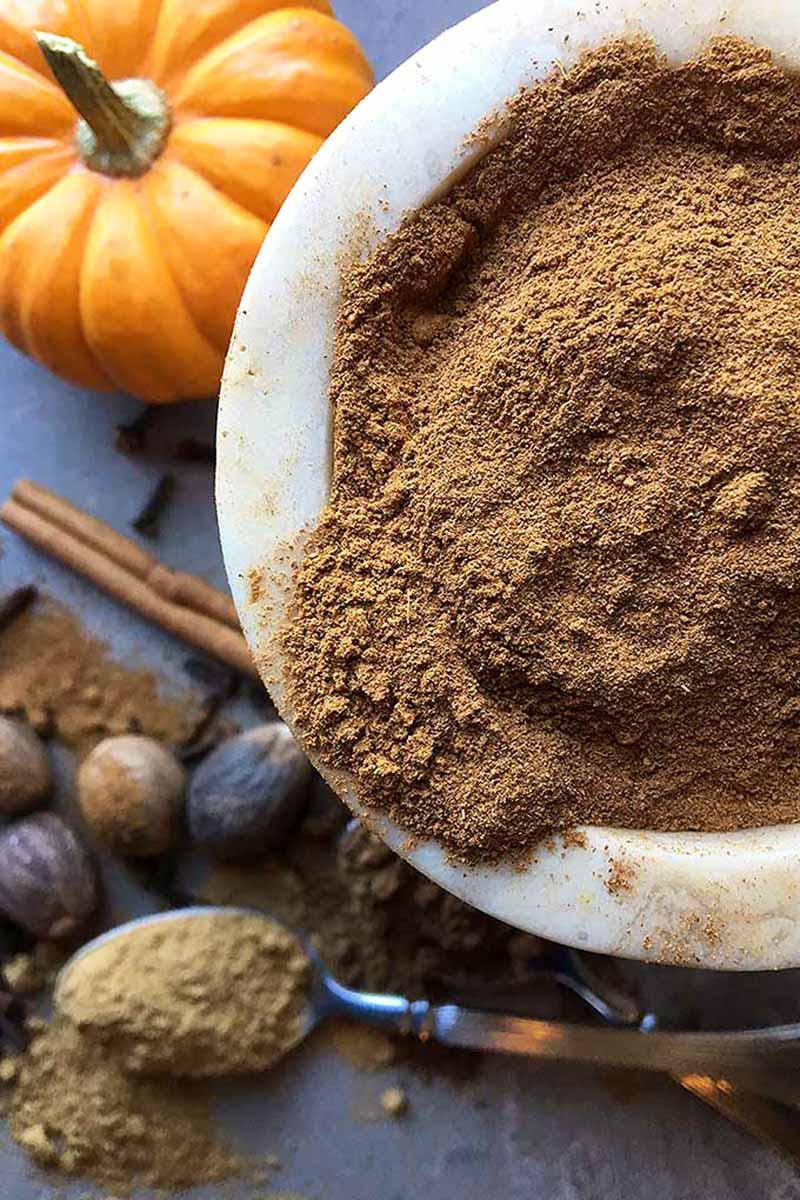
Pumpkin Pie Spice Blend – Get the Recipe Now
They’re easy to mix at home with ingredients you likely already have in your spice rack, and it’s easy to scale a batch to size, so you can make more or less as you like.
The basic ingredients of PPS are simple, and typically include allspice, cinnamon, cloves, ginger, and nutmeg.
The fall flavors come vibrantly alive when seasoned with all of these comfy and cozy warming spices!
They’re the perfect combination for the sweetly nutty taste of winter squash. Blended together, they do magical things that transform and enliven a plethora of recipes.
Need to make a batch for the holidays? Our pumpkin spice recipe spells it all out step by step.
5. Savory Dishes
Highly versatile, the thick-walled baking or sugar varieties add their rich flavor to savory foods as well as sweet dishes.
These varieties are scrumptious as a side dish when cut into cubes, lightly coated with olive oil, simply seasoned with freshly milled salt and pepper, then baked on a sheet pan. You can try it either by itself or with a medley of other roasted fall vegetables like carrots and potatoes.

Pumpkin Kamut with Pecorino and Hazelnuts – Get the Recipe Now
Sliced into sticks and lightly seasoned, they make healthy and tasty baked fries – a nice alternative to potatoes and yams.
And you can use them as a substitute in any of your favorite butternut squash recipes.
When cubed, they add unique flavor and silky texture to dishes like chili, curry, pot pies, and stews. And when the cooked pieces are served cold, they add a sweet, earthy flavor to salads and slaws.
The puree makes an excellent featured flavor for entrees like risotto, gnocchi, and pastas such as lasagna, mac and cheese, manicotti, or ravioli. You won’t want to miss out on the outstanding flavor combo of squash and sage in this rich and creamy pasta sauce.
Even the blossoms are edible – try them battered and lightly fried for a tasty appetizer or tapas plate.
You can also use the plain, unseasoned puree for a flavorful and nutritious baby food!
6. Seeds and Trail Mix
Like the bright orange flesh, the seeds of a squash provide excellent nutrition, the perfect healthy snack option.
High in dietary fiber, they’re also a good source of calcium, iron, phosphorus, potassium, and protein.
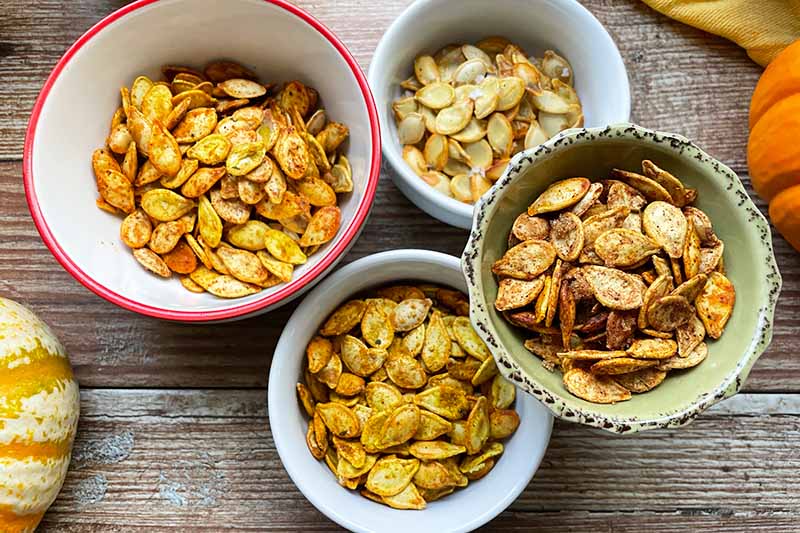
Toasted and Seasoned Pumpkin Seeds – Get the Recipe Now
The shelled, raw seeds have a rich, nutty flavor and crunchy texture that are well-suited for garnishing dishes like cereal, granola bars, oatmeal, and yogurt.
They also make a delicious salad topper, and are an ideal ingredient in mixed nut blends, like maple-spiced nuts and seeds.
For a hearty trail mix, blend shelled seeds with raw cacao nibs, dried cranberries, sunflower seeds, plus a sprinkle of cayenne for a satisfying and subtly spicy autumnal snack.
Or try toasting the seeds with the shells still on. Review our recipe for toasted seeds. We’ll give you thorough advice every step of the process, as well as give you some tasty seasoning suggestions.
7. Soups
Few things are as comforting as a bowl of hot soup at the end of a long day or after time spent outdoors in the crisp fall air.
And the velvety texture and rich flavor of our favorite cucurbits is the perfect ingredient for creamed soups, like this creamy and comforting pumpkin soup.
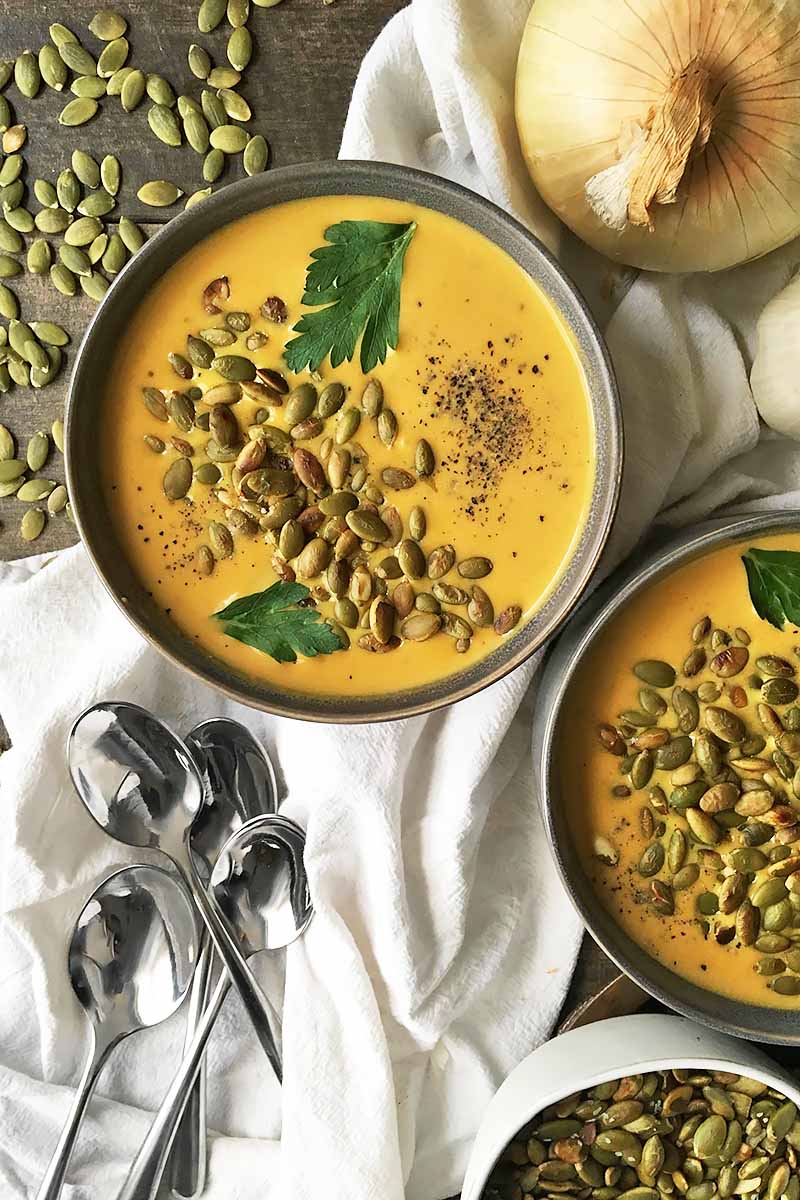
Creamy Pumpkin Soup – Get the Recipe Now
Or you can warm up from the inside out with a bowl of flavorful curried soup seasoned with other warming spices like curry, coriander, and cayenne.
And as all parts of the cucurbits are edible, don’t toss the guts and seeds from a Halloween carving session. They’re perfect for adding flavor and nutrients to a big pot of simmering vegetable stock along with the likes of celery, carrot, kale, and onion. It’s a smart way of repurposing food scraps.
8. Birdfeeders
With such a wide range of uses, there’s no way you can think that pumpkin is for the birds…
But it certainly can be!
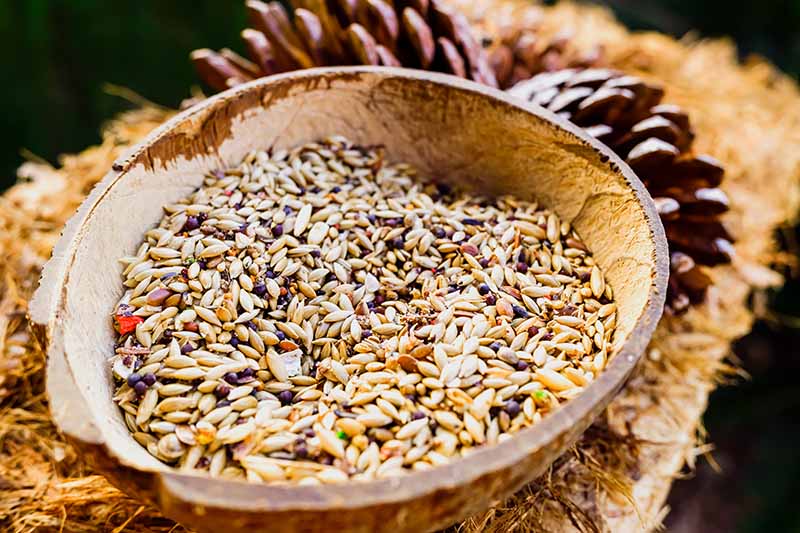
The seeds are rich in protein and healthy fats, making them a natural for hungry winter birds.
Make a birdfeeder blend by mixing them with the likes of cracked corn, white millet, nyjer seeds, peanuts, and sunflower seeds to attract a wide variety of migratory and overwintering feathered friends.
In really cold temperatures, you can provide birds with an extra energy boost by mixing the above grains and seeds with suet and small pieces of dried, sugar-free fruit like apples, cranberries, and raisins.
9. Compost Builder
Once the fall holidays are done and dusted, you may still have gourd remnants to deal with that are a little worse for wear.
They can be added to your compost bin!
Flesh, rind, and stems all break down quickly and add important nutrients and tilth to the budding soil.
But hold off on putting the seeds in your compost, unless you know they come from heirloom or open pollinated stock – they’ll sprout like crazy come spring, even after freezing. You’ll have an abundant supply of seedlings, but if they’re from hybrids they probably won’t produce fruits the same as their parents, if they fruit at all.
If you don’t have your own compost containers, put out your leftover pieces for pickup and processing in your local food waste collection program.
10. Holiday Decor
To honor the autumn season, or celebrate occasions like Halloween and Thanksgiving, gorgeous orange gourds are an ideal accessory for indoor and outdoor decorations.

It’s easy to create a harvest scene for entryways, foundations, and porches by displaying them with a variety of colorful chrysanthemums, a bale or two of hay, and a stand of golden grains or ears of corn.
If you’re not into carving gourds for Halloween, they’re easy to paint after wiping clean and drying. Use fast drying and easy-to-clean acrylic paints – available at any art supply store – to paint haunted faces, stencil on leaf motifs, or create your own signature graphic designs.
For a unique centerpiece, stack or pile a few colorful, flat-topped sugar varieties in the center of your dining table for a seasonal theme. Pair them with other fall decor for a beautifully themed Thanksgiving table.
And hollowed and carved pumpkins are the gourd of choice for jack-o’-lanterns!
But they’re also great for carving into sturdy holding vessels for seasonal dinner parties. Cut out a wide-mouth lid and scrape away the innards to make a handsome punch bowl, salad bowl, soup tureen, or wine cooler for fit for any harvest, Halloween, or Thanksgiving celebration.
11. Stressed Skin Soother
If you have any leftover puree, it makes a superb anti-aging facial for stressed skin.
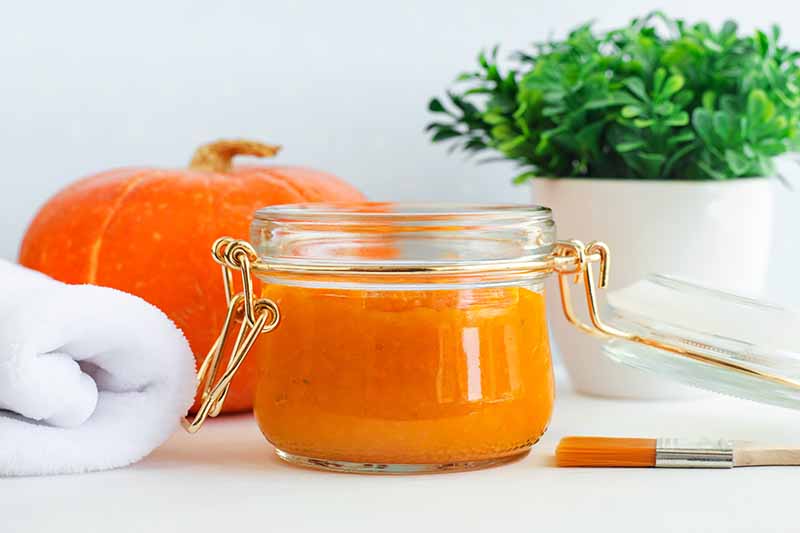
It has anti-inflammatory compounds that sooth skin cells, enzymes to gently exfoliate, and vitamins A and C to help firm and protect the skin.
Combine 1/2 cup plain puree with two tablespoons finely ground almonds, one tablespoon each plain unflavored yogurt and honey, plus a few drops of almond or extra virgin olive oil.
Apply to the face and throat and allow to sit for 15 minutes. Then, rinse it completely off with cool water for soft, smooth skin.
Sweet Fall Fare and Fun
Beautifully colored with richly flavored, velvety flesh, pumpkins are sweet fall fare with an impressive range of uses.
Use the richly flavored sugar or pie varieties as a delicious ingredient in savory and sweet foods.
The carving types don’t have the same sweetly nutty flavor, but they make the best jack-o’-lanterns and holding vessels for a festive punch or creamy soup.
The seeds from both types are delicious and nutritious, raw or toasted. And remember, winter birds appreciate the healthy seeds too!
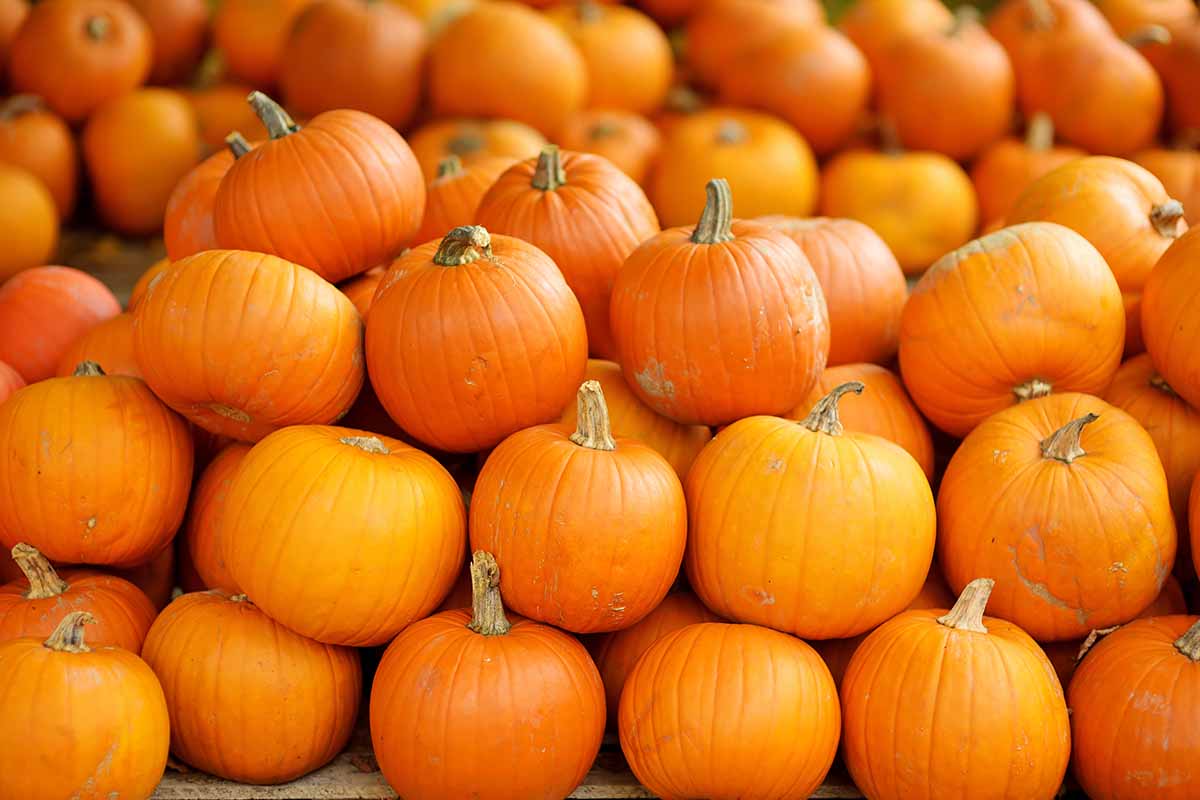
And you can even treat yourself to a relaxing spa day at home using the unseasoned puree in an all-natural facial mask!
What are your favorite ways to use this fall classic? Tell us about them in the comments section below.
And for more autumnal inspiration, add these seasonal guides and tutorials to your reading list next:
About Lorna Kring
Recently retired as a costume specialist in the TV and film industry, Lorna now enjoys blogging on contemporary lifestyle themes. A bit daft about the garden, she’s particularly obsessed with organic tomatoes and herbs, and delights in breaking bread with family and friends.

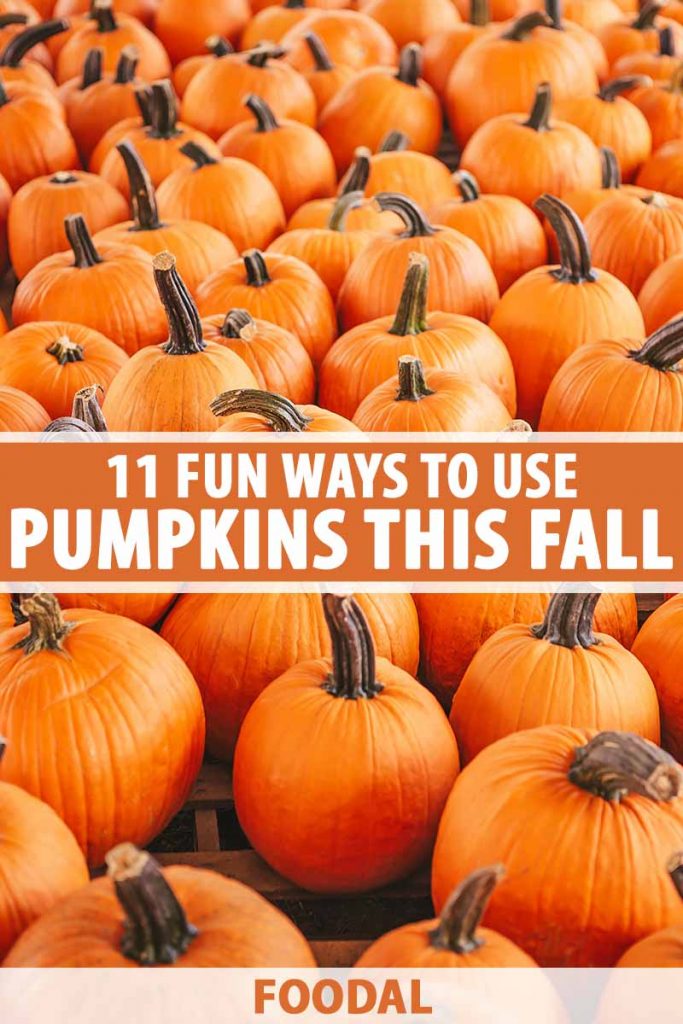



When living in Puerto Rico pumpkins grew abundantly right in my yard, as did many other vegetables and fruit. I often used it in meals. In beans, soups, stews, boiled and mashed, fritters ( a favorite of my son’s and his friends but way to sweet for my liking).
I had never considered using it for smoothies but will have to try it, I knew it had health benefits but did not know until reading it here that pumpkin is a good source of Iron. I am also liking the vegan mac and cheese recipe. Quinoa is a pantry staple in my home and the vegan mac and cheese is something I think I would be great to make on work days as it is pretty simple with out a lot of prep time needed.
I’ve never been a big squash fan – my mother used to love acorn squash roasted with maple syrup, or spaghetti squash with butter and salt, but I would only ever tolerate enough to keep me from getting the evil eye at dinner. As an adult, I’ve tried to resample foods that I detested as a child, and some I’ve grown to enjoy! Not so much the squash, though (though I haven’t given up on it!) I can say, however, that for Christmas my future MIL brought a couple of gooseneck squash pies. Oh MY were they tasty! A much more delicate flavor than pumpkin pie, I think it was really the best way to end a rich Christmas dinner – on a lightly sweet note.
Jen, I’m like you. Those foods that were nasty as a child are now great! Some things are definitely an acquired taste and I can see how cucurbits may be one of those for some people. I’ve got a few foods that I’ve never acquired as taste for. Hominy being the leading example!
These are great ideas. I pick up pumpkins whenever they’re available at our local fruit stand. I think the fresh ones taste better than the canned variety. I would have never thought of using them for a facemask. I usually whip up a big batch of pumpkin soup, I take it to work for lunch and it freezes great.
I never knew that about the Ukraine! What a novel – and… well kind of insulting – way to say nope. I don’t think pumpkin will ever be better than anything other than food though. I happen to love pumpkin soup, seeds, muffins… pretty much anything. I’ll have to try that pumpkin smoothie though – that looks delicious!
To be honest with growing up on a farm I feel silly for not knowing this. I knew it was healthy but I didn’t realize just how healthy pumpkins are! So that was nice to read about. My mom does more of her cooking with squash though. She does squash in the oven, sometimes mashed and even makes a pretty cool soup. Maybe Christmas 2015 I can talk her into making some Pumpkin Pie.
WorkAtHomeGal, try looking at Kobacha – it’s a Koran/Japanese cultivar that is kind of a mixture of both squash and pumkins. Green on the outside but with orange flesh that makes a great soup. Koreans make a very tasty soup out of this with a little sweetener, rice flour for thickener, a few black beans scattered in there, and sometimes they throw in some dried jujubes.
Alright, i confess i had no clue that one can be so creative when it comes to all things pumpkin, all i know about pumpkins is plopping it in my pan and finally it ending on my plate at dinner, what caught my eye and somehow my senses is the pumpkin-pie smoothie, being a fanatic of smoothies, you can bet that has gone down in my long list of smoothies awaiting to be produced…oh, i can’t wait 😉
I have a question off the record…what do i do with the pumpkin seeds…i understand they are very beneficial to the human body…i ate some pumpkin last week and in the process i decided to harvest the seeds..in my mind i thought they’d come in handy but now am clueless…sort of stuck :(…any ideas?…i have read about the seeds and trail mix above …just wondering if there are other ideas to top this one wonderful idea 😉
I had no idea that pumpkins had so many benefits! I definitely want to try the Vegan Mac-N-Cheese. I have been looking for a substitute for mac and cheese since I have been put on a plant-based whole foods diet. I actually made your Chicken Mac-N-Cheese for my husband as a birthday meal but none for myself since it’s not part of my diet. It looked and smelled so good. So I’m really glad I came across this article.
I am very curious about making pumpkin into a face mask. I have been noticing a lot of wrinkles on my face lately, haha!
I also did not know about using these fruits as a face mask. Must be a raw pumpkin used to make the mask? I have only canned right now but will try to get a fresh one just to give it a try. The smoothie even sounds good.
Great article. I should have looked into this first — it’s like all the basics are there. For me, pumpkins were always mysterious things, we had the spaghetti squash, but my mom always prepared that herself. When I carved my Halloween pumpkin, I had no idea how to use any of the inside to make stuff like my friends!
It looks like you can just put “slices” straight to cook and the inside becomes soft.
It really makes me want to go and have a nice pumpkin soup! But I also look forward to trying these different methods. Thanks!
As much as I like roasted pumpkin and pumpkin soup, I have yet to prepare one myself. Love the idea of a vegan mac and cheese, because I do love the dish, but not the calories that go into it. I do like to have vegan days and dishes that require as little work as possible.
I’ve never considered using pumpkin for much of anything outside the kitchen, but the face-mask idea definitely sounds like something to try. I always love when “pumpkin season” rolls around and a little bit of everything features the iconic orange squash. I’ve found myself making more savory recipes with pumpkin recently, like a lightly-salted pan roast treatment. The sweet-savory combination is something my family and I have been exploring more than the classic “sweet” recipes for pumpkin, although the smoothie seems like a fantastic idea.
I’ve always loved pumpkins and squash and since starting to eat and live by paleo principals I have become quite passionate about them. Squash is such a versatile dish. I really recommend spaghetti squash served with a simple butter and garlic “sauce”. So delicious and very healthy. Spaghetti squash has replaced pasta for me. Great blog. Long live pumpkin! I absolutely love fall because of how abundant squash and pumpkin are. I’ll have to figure out a paleo pumpkin pie recipe for this coming year. I sure do miss it.
My absolute favorite thing to do with just about any sort of squash is the simplest method imaginable: roast it with salt and olive oil. I have yet to find any vegetable that doesn’t taste amazing this way; even stuff that’s typically bitter, like broccoli, gets this sweet, caramelized taste after the olive oil and oven treatment. By far my favorite though is butternut squash. Pumpkin is up there, too!
You bring out so many uses for the pumpkin here, this is interesting and helpful. I love that I can make an exfoliating mask with it. I am looking forward to trying the recipes; they seem delicious. I have not really cooked pumpkin, but I have eaten some that was solar-cooked with onions and peppers, and it was sooooo good. The sun just brought forth all the flavor. I do like pumpkin seeds too and the idea for a trail mix. Thanks for sharing and giving references. It is amazing how so much nutrition is in something we only used for carving out a face.
I absolutely love pumpkin, so I loved reading all of the benefits and the history too! That smoothie looks absolutely amazing! I have to admit that I’ve only ever made pie and cheesecake, and that’s the most of my cooking experience with pumpkins, but it can definitely be so much healthier, as your post shows 🙂 I’m definitely going to have to try that smoothie!
Great article! I have a question: It seems like you can utilize every aspect of a pumpkin except the stubborn stem. Is there any culinary usage you can get from the stem. Perhaps, in a broth? If not in a food related way perhaps something else? I like to utilize everything I possibly can
Wow, pumpkin can be used in so many different ways! One of my favorites is roasting it in the oven with herbs and mixing it through pasta with a cream and goats cheese sauce. I top it off with walnuts for some crunch. Oh gosh, I’m getting hungry just typing this out!
That that sounds….very very good! I’m going to have to throw those ingredients together and see what I can come up with.
Since I’m a big fan of pumpkin already, I’ve seen a lot of these suggestions before. But! I’ve never heard of the vegan mac-n-cheese idea. That sounds really delicious, and really creative. I would have never thought to use it as a creamy sauce substitute. What a great idea! Thanks for sharing. Off to get a pumkpin…
Until this year, thanks to a friend I now know that all forms of squash are edible. I have seriously been living my life thinking some of the weird looking ones were strictly for decor. The greatest joy I get from now knowing the truth is that there is a unique yet delicious taste to all squash. Now I have another joy, which is all these wonderful recipes to try!
Great tips. I love pumpkins. their subtle sweetness is always a welcome addition to savory dishes and creamy soups. On top of their delicious properties, they are also some of the healthiest vegetables around. You can’t go wrong when serving pumpkin based dishes and desserts.
Wow, I’ve never thought that you can do so much with pumpking. That’s neat!
I’ve only ever used them to make pumpkin pie, soup and carve them out when the Halloween season came around.
Those recipes seem nice!
This post makes me want pumpkin soup right now. Or pumpkin spice cake. I never would have thought to use it with quinoa for a mac ’n’ cheese alternative, though. It sounds absolutely delicious, I’ll have to try that out when it’s squash season again. A pumpkin face mask sounds luxurious too!
So many great ideas in one article. The three sisters stew sounds delicious and fairly easy to prepare. I’ve never thought of using pumpkin or squash in a face mask, but it sounds beneficial, and I’d better prepare dinner ahead of time, because this is one of my favorite fruits, and one of the reasons I so look forward to Fall. I can’t wait to roast some pumpkin seeds in a few months.
I laughed when I read that about the rejection of a proposal with pumpkins in France. I’m guilty of only using pumpkins for dessert and Jack-o’-lanterns, but this opened up my mind towards new possibilities, especially the face mask. This was an excellent read overall, and I learned quite a bit. Thank you for the article!
I love Pumpkin pies my husband would rather have sweet potato pie instead. I’m just in love with the pumpkin there are so many things that can be done with them from eating to decorating I mean it really does keep on giving. How lucky are we to be able to go to the pumpkin patch and pick our very own.
When I was a little kid I used to hate pumpkins from the bottom of my guts. I couldn’t stand them but I actually never got to taste them in a correct way. Once my mother made some pumpkin pie I thought I’d give it another go, and I’ve been hooked every since. I now love to make pumpkin pie and soup, especially when it’s Halloween.
It’s always good to learn more uses for these guys. They will be overabundant soon, so I can’t wait to try some of these ideas. I’ve always love preparing and eating the seeds.
I’m always on the lookout for new uses, because I don’t like wasting the ones I decorate. I also know people who grow them, so I usually end up with more than my share.
Thanks for this.
Wonderful recipes! I am a pumpkin-a-holic this time of year. If any gardeners are reading this, try growing the “jerruhale” pumpkin;, they are green with a light gray “patina” and they are SO sweet and delicious!
I love the smoothie. Pumpkin also goes lovely in risotto which I make in a pressure cooker.
And my favorite fall breakfast: pumpkin pie in a cup:
Blend:
1 egg
1/2 c. oatmeal
1/2 c. pumpkin
1T. Maple syrup or honey
Pumpkin pie spice to taste
Pour it in a mug and microwave for 1.5-2 minutes.
Enjoy with more syrup and spray whipped cream for the full effect!
Thank you for your fall pumpkin focus–I am really enjoying all of your ideas!
Well, it is all the rage right now. Everything I see, seems to have “pumpkin” in the name. I get that it’s the season for it, but wow. It’s everywhere. I like it and all, but I’d rather try some of these ideas rather than go out and buy a bunch of (probably artificially) flavored stuff.
That first picture looks so pretty, too. I should totally display some things that way. What a festive touch for a holiday meal.
Pumpkins are so healthy, and delicious. I used to hate them for some reason, as a kid, but now I love them and can’t get enough when they are in season. My girlfriend made pumpkin cheesecake for Halloween, I was skeptical at first, but it turned out really good.
I find it interesting that there are so many ways to use this incredible fruit. I knew about pumpkin soup and pie of course but the smoothie really surprised me. I have to try it out. Thanks for sharing this.
Pumpkins and really any type of squash are surprisingly useful for extended soups without adding a ton of meat. If you cube the pumpkin into small squares, you can add it to any chicken or beef soup and it will absorb so much meat flavor, and the texture can be similar to something like chicken breast, that those eating the food will not even know it is not chicken they are eating. It is great for big events where you are making a ton of soup and an´t afford a lot of meat for it.